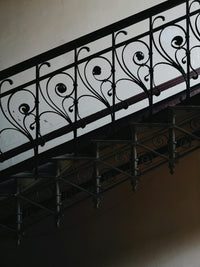I’ve noticed that a lot of people mix up the terms "banister" and "baluster." It’s something that comes up often when talking with clients—many use the words interchangeably without realizing they refer to different parts of a staircase. If you’ve ever been confused about which is which, you’re not alone.
In this article, I’ll break down the key differences between a banister and a baluster so you can understand what each one is and how they work together. I’ll also touch on the term "balustrade," which is related but slightly different. Let’s get right into it.
Banister vs Baluster: Understanding Staircase Terms
Banister
The term banister typically refers to the handrail of a staircase—the part that people grip for support while going up or down the stairs. It runs parallel to the incline of the staircase and is securely mounted on top of the balusters or, in some cases, directly attached to a wall with brackets.
While "banister" is commonly used in everyday language, especially in the U.S. and the U.K., it’s technically a more informal term. In architectural and construction settings, "handrail" is often the preferred term, as it more clearly describes its function.
Also, people often use "banister" to refer to the entire railing system, including the balusters and newel posts, but its correct meaning is just the handrail itself.
Baluster
A baluster is a vertical post or spindle that supports the handrail of a staircase. These posts are spaced evenly along the length of the stairs and serve both a structural and safety function by preventing people from falling through open gaps.
The term "baluster" comes from the Italian word balaustra, which refers to the shape of a pomegranate flower—many traditional balusters have a curved, vase-like design inspired by this. However, modern balusters come in many styles, from sleek metal rods to minimalist glass panels.
Although balusters are a key part of a staircase railing, they are sometimes confused with the entire system. When grouped together with the handrail and other supporting elements, they form a balustrade. In some cases, especially in the U.S., balusters are also referred to as spindles, particularly when they have a thinner, more delicate shape.
Key Differences Between Banisters vs. Balusters
1. Function
-
Balusters: Stand upright to support the handrail and keep the staircase safe by filling gaps and preventing falls.
-
Banister: Runs along the top of the balusters, giving you a sturdy handhold for support while using the stairs.
2. Position
-
Balusters: Are installed vertically between the steps (or floor) and the handrail, evenly spaced to provide both support and safety.
Building codes typically recommend a spacing of no more than 4 inches (about 10 cm) apart to prevent small children from slipping through. -
Banister: Is the horizontal part of the railing system, mounted on top of the balusters and following the incline of the stairs (except in cases where there are no stairs, in which case the banister runs parallel to the floor).
The recommended height for a handrail is typically between 34 and 38 inches (86-97 cm) from the stair tread, depending on building codes.
3. Design and Aesthetics
-
Balusters: Often the most detailed part of a railing system, balusters can be customized to match different home styles. Wooden balusters work well in traditional or rustic homes, while metal ones, like wrought iron or steel, suit modern and industrial spaces. Glass balusters are a good choice for a contemporary, open feel. Since they make up most of the railing, balusters play a big role in how the staircase fits into your home’s overall design.
-
Banister: The main purpose of a banister is to provide a secure handhold, so safety comes first in its design. Many are made with that in mind, keeping a simple shape and a strong, durable build. Banisters also come in different materials, colors, and finishes to match the balusters and the rest of the staircase. In some cases, they are made from a different material than the balusters, like a wooden handrail paired with wrought iron balusters.
Introducing the Term "Balustrade"
People don’t use the term balustrade as often because, as I mentioned earlier, many just say banister or baluster when talking about the whole railing system. But that’s where balustrade comes in—it’s the correct term for the entire structure. A balustrade includes all the parts that make up the railing system: the banister (handrail), balusters (vertical posts), newel posts (larger support posts at the ends or turns), and sometimes a base rail (a horizontal rail at the bottom that holds the balusters in place).
Conclusion
I hope this article helped clear things up when it comes to railing systems and their parts. Now, if someone mixes up a banister and a baluster, you’ll be the one to set them straight. If you still have questions, feel free to ask—we’re always happy to help. And if you’re looking for custom wrought iron banisters and balusters, be sure to check out our website.
Common Questions About Railing Systems
Q: Are balusters and spindles the same?
A: Technically yes, but there’s a small difference. Baluster is the proper term for any vertical post supporting the handrail, while spindle usually refers to a thinner, more decorative version, especially in wooden railings. Most people use them interchangeably, so either one works in casual conversation.
Q: How do you clean and maintain different types of balusters?
A: Different materials require different cleaning methods and products to keep them in good shape. Here are the most common ones:
-
Wooden balusters – Dust regularly and wipe with a damp cloth. Use a wood cleaner for deeper cleaning and occasionally apply polish or sealant to protect the finish.
-
Wrought iron or metal balusters – Dust them and wipe with a damp cloth. For rust prevention, check for any scratches and touch up with paint or a rust-resistant coating as needed.
-
Glass balusters – Clean with glass cleaner or a mix of vinegar and water to remove smudges and fingerprints. Use a microfiber cloth to avoid streaks.
-
Stone or concrete balusters – Wipe with a damp cloth and mild soap. Avoid harsh chemicals that could damage the surface, and check for cracks that may need sealing.
Q: Can you replace just the banister without changing the balusters?
A: Yes, you can replace just the banister without changing the balusters, but there are a few things to check first. The new banister needs to fit the existing balusters, both in size and attachment method. If the old banister was glued or nailed in place, removing it without damaging the balusters can be tricky. Also, if the balusters are weak or outdated, it might be worth replacing them at the same time for a more secure and updated look.
Q: What’s the best material for a durable outdoor balustrade?
A: The best materials for a durable outdoor balustrade are wrought iron, stainless steel, and aluminum. Wrought iron is strong and classic but needs rust protection. Stainless steel is corrosion-resistant and low maintenance. Aluminum is lightweight, rustproof, and great for all weather conditions.
Q: Do all staircases need balusters, or can you have a railing without them?
A: No, not all staircases need balusters, but most do for safety. Some designs use glass panels, cable railings, or solid walls instead. As long as the railing system meets safety codes and prevents falls, balusters aren’t always necessary.









